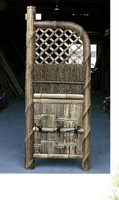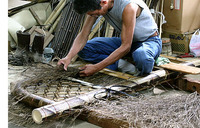

Total:131items
- Pottery & Porcelain (18)
- Lacquerware (4)
- Glasswork (2)
- Wood & Bamboo Work (19)
- Hakone Yosegi Zaiku: Hakone Marquetry
- Boshu Uchiwa: Boshu Fans
- Nikko-bori: Nikko carving
- Sasebo Koma (Sasebo Spinning Top)
- Shimoda Yanimatsu Zaiku (Shimoda Joinery of Oily Pine)
- Echizen Takeningyo (Bamboo Dolls)
- Osaka Senshu Kiri-dansu: Paulownia chest of drawers or wardrobes of Senshu, Osaka
- Kitayama Maruta: Japanese cedar logs
- Yodoegasa: Yodoe umbrella
- Atami Kusu Zaiku: Atami Camphor wood crafts
- Kawatsura Kokeshi Doll
- Itaya Zaiku: Itaya Bark Craft
- Yokohama Classic Furniture
- Hinaga Uchiwa: Hinaga Fan
- Torafu Takezaiku: Tiger Bamboo Work
- Tsuruzaiku: Woven Vine Craft
- Okawa Kumiko: Okawa Kumiko Wood Joinery
- Shuro Houki: Hemp-palm Broom
- Furyumen: Wood Carving Mask
- Leather Work (1)
- Papermaking (13)
- Textile (20)
- Dyeing products (5)
- Masonry (1)
- Metal Work (11)
- Stationery (4)
- Livingware (3)
- Accessory (4)
- Toys & Entertainment (14)
- Interior (2)
- Other crafts (10)

 |
Main Production Site:Kochi |
 《Characteristics》
《Characteristics》Torafu-dake, or tiger bamboo is a type of henon bamboo, whose name derives from the tiger-striped brindle pattern on its surface. Bamboo is a plant with a strong life force, growing rapidly into the same height as its parent in three months, becoming available for processing in three to four years. Bamboos are considered to be an only truly sustainable natural resource, which is vital for our time with environmental issues. In an interview conducted by BBC, brindle bamboo was described as 'miraculous' for its mysterious nature. Makino Botanical Garden, named after Dr. Tomitaro Makino, an internationally renowned botanist who gave the name to this type of bamboo, is located at Godaisan in Kochi City where you can find transplanted brindle bamboos. Many experiments of transplanting brindle bamboos to different areas have not been successful, producing no beautiful pattern on the surface. The transplantation in Makino Botanical Garden was an exception; however, the tiger-striped brindle pattern produced here is still imperfect. Brindle bamboos are indeed a miraculous product of the climate of Awa.
Traditional Craft Officially Designated by Governor of Kochi Prefecture
Contents provided by: Taketora, the Tiger bamboo brand
Translation by: Moe Shoji

| Materials | Tiger bamboo, or tiger-striped brindle bamboo |
|---|---|
| Crafting Processes | [How to make a sodegaki, or a low fence for the gate]
1. Framework Making a core with Mosochiku bamboo, or Phyllostachys pubescens The fences have a core made of another type of bamboo (Mosochiku bamboo, or Phyllostachys pubescens) although they look as if they are made out of a single bamboo. We use 3 to 4 year-old bamboos to create a core of the fences. Craft of making fences called, Tamasodegaki Small triangular notches are made in the Mosochiku bamboos which will become a core of the fence. One corner of fences of this type usually has a gentle and beautiful curve. This curve is created by bending the bamboo by making these notches. Beauty of the curve Some ask whether we apply any heat on the bamboo to bend it. The answer is "no" ? beautiful curves are perfected by making small notches in the core bamboo. Joints of the framework Thinner bamboos are inserted into the holes made in the core bamboo to create a joint. Bamboo pegs Normal metal nails cannot be used for bamboo work since bamboos are hollow inside. Instead, we use bamboo pegs (a piece of bamboo curved into a stick with a tip like a bamboo skewer) of various sizes to join the parts of the framework. You can make sure that parts are firmly joined by using a slightly larger peg than the hole. 2. Lattice work Creating lattice work Tiger bamboos are split into equal width, which are woven back to back into a symmetrical shape. Once these are fixed by bamboo pegs, the sections where bamboos are crossing are neatly tied, using Shimanto vine. Shimanto vines Shimanto vines are native plants found across the upper reaches of Shimanto River, a grand river which penetrates Kochi Prefecture. Vines need soaking in the water for two days to soften them since they are normally stored after being dried. 3. Takemaki: Wrapping the strips of bamboo A vital moment to show the prowess of craftsmen The process of "takemaki" is where the brilliant skills of craftsmen are tested. They wrap the core of Mosochiku bamboo with thinly split strips of tiger bamboo. Wrapped bamboo strips of "Tamasodegaki" are narrower, compared to those of "Tsunosodegaki". It requires a mature technique and advanced skills in order to neatly place all the strips with their patterned surface on display. Pattern made with bamboo joints One of the characteristics of bamboos is their joints. Craftsmen draw interesting patterns with these joints, by shifting where the joints appear ever so slightly while wrapping the core. 4. Finish Kurobo, or bamboo branches Bamboo is a wonderful material without every single part has its own use. Branches of bamboos are also collected to be used as part of the fences. Hishigi Hishigi is made by flattening a piece of round bamboo until it becomes completely flat. The more delicate and careful the flattening work is, the more beautiful and workable material a hishigi becomes. When bamboo-made fences were very popular, there used to be several craftsmen who are specialised in this process of flattening bamboos and the lively sounds of smashing bamboos were heard throughout the day. Decoration A piece of bamboo as a decoration is placed on the top of another piece of bamboo which is holding a series of hishigi. Ropes of windmill palm Ropes made of windmill palm have traditionally been used as gardening materials since they are tough and sturdy. Windmill palm is also known to be a material for broomsticks. The fences are finished using this rope, embellishing the decorative bamboo pieces. |
| History | "Tiger bamboos" and Dr. Tomitaro Makino
The name of this bamboo, "Tosa Torafu-take", was given by Dr. Tomitaro Makino who was born in Kochi Prefecture, an internationally known botanist who calls himself a spirit of trees and plants. It was in 1916 that Dr. Makino named this unique type of bamboo: A variety of henon bamboo, produced in Awa, Shinjo Village, Takaoka District, Kochi Prefecture (current Awa, Susaki City). General features are similar to that of henon bamboo; however, numerous brindle-stripes of brown colour can be observed on its surface. I transplanted this bamboo to my botanical garden in April 1912, and am currently conducting experiments, yet the result has not yet been successful. History The history of this craft work dates back to 1894, when Usaburo Yamagishi started his business a bamboo merchant in Tennoji Ward, Osaka City. At that time, bamboos were so deeply rooted in people's daily lives that one could find at least one craftsman specialised in bamboo work in every single village. Bamboos were widely used as materials for farming, fishery, building construction, gardening, and tools for everyday life and daily routines. This made it possible for Usaburo to embark on his business, supplying bamboos to various customers with different needs. As Usaburo travelled across Japan in search for bamboos of a good quality, he finally came across "Torafu-dake", or tiger bamboo, which literally has a stripe pattern similar to that of tigers. Tiger bamboo had not been widely known despite its superior quality for which they were once presented as annual tribute to the feudal lord of Tosa Domain (current Kochi Pref., Western Japan ), the Yamanouchi family. This was partly because of the geography of Awa which used to be difficult place to get to and also because of the export ban on the tiger bamboos placed by the local government. Usaburo also built a bamboo manufacturing factory in the city of Kobe where he started to produce fishing rods in 1915, and he actively engaged with exporting his products. Bamboo products made in Japan at that time had a great reputation in Europe, thanks to the high quality of the material and developed processing skills, which attracted several bamboo makers to one of the major port cities of Kobe. Yoshiharu, a son of Usaburo, started to support his father's business as the era turned to Showa period (20c). They extended the bamboo forests in the area in cooperation with the landowners, replacing cedar and cypress, because Torafu-dake only successfully grows in this Awa valley. In March 1970, they opened the exhibition centre for bamboo products and craftworks. |
| Related URL | http://www.taketora.co.jp/ |
◆Exhibition / Showcase
Taketora Headquarter
913-1 Awa, Susaki-shi, Kochi
TEL: +81 (0)889-42-3201 (Japanese only)
Opening hours: 9:00 AM - 5:00 PM
Access:
By car: 4 minutes from Michi no Eki "Kawauso no Sato Susaki",
By taxi: 7-8 minutes from JR Susaki Station,
On foot: 2 minutes from JR Awa Station.
Assistance needed? For inquiries in English:
JTCO Contact Form
Your inquiries will be forwarded by JTCO in Japanese to the organization you wish to contact.
*Please write the name of craft you wish to ask about.



